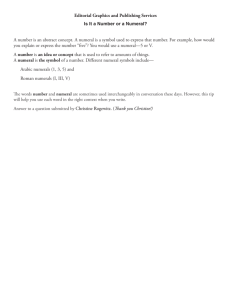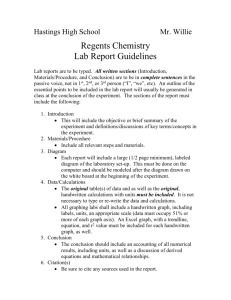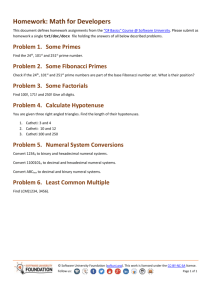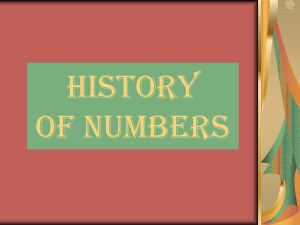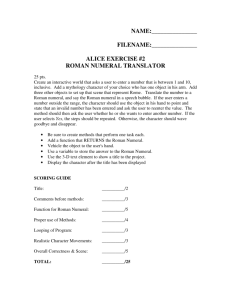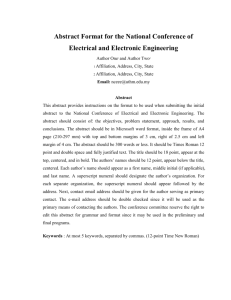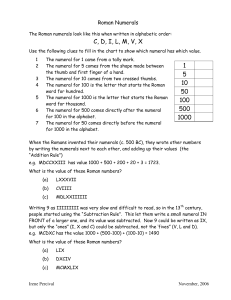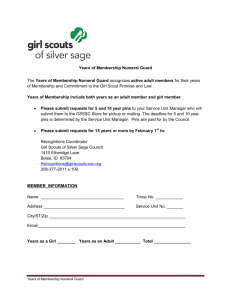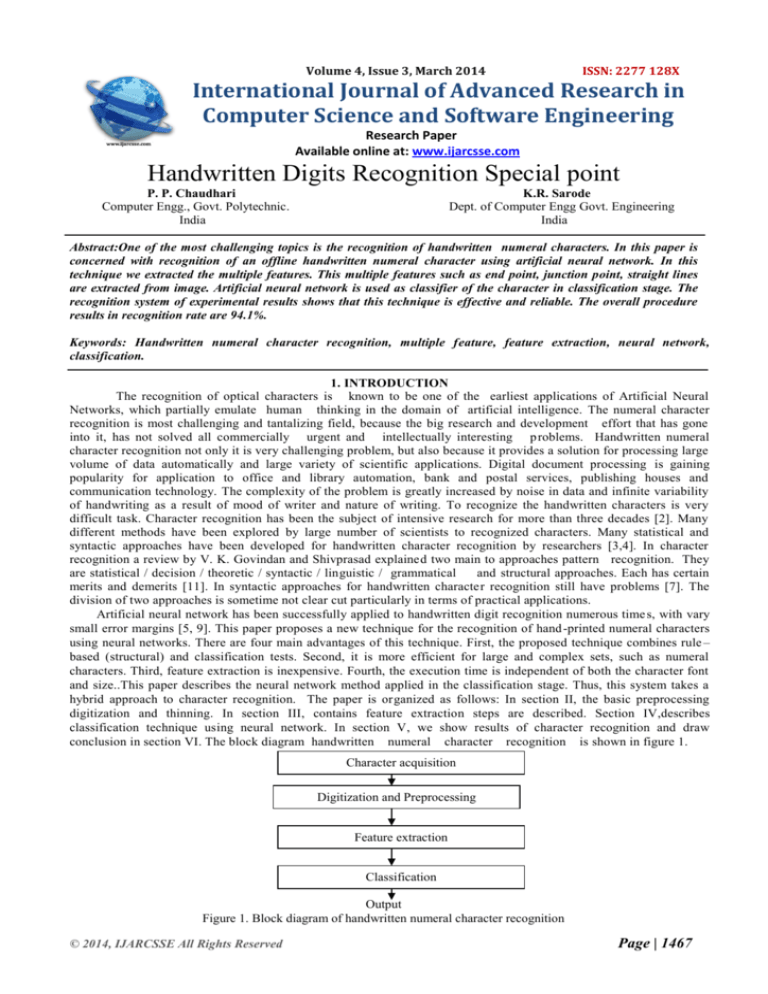
Volume 4, Issue 3, March 2014
ISSN: 2277 128X
International Journal of Advanced Research in
Computer Science and Software Engineering
Research Paper
Available online at: www.ijarcsse.com
Handwritten Digits Recognition Special point
P. P. Chaudhari
Computer Engg., Govt. Polytechnic.
India
K.R. Sarode
Dept. of Computer Engg Govt. Engineering
India
Abstract:One of the most challenging topics is the recognition of handwritten numeral characters. In this paper is
concerned with recognition of an offline handwritten numeral character using artificial neural network. In this
technique we extracted the multiple features. This multiple features such as end point, junction point, straight lines
are extracted from image. Artificial neural network is used as classifier of the character in classification stage. The
recognition system of experimental results shows that this technique is effective and reliable. The overall procedure
results in recognition rate are 94.1%.
Keywords: Handwritten numeral character recognition, multiple feature, feature extraction, neural network,
classification.
1. INTRODUCTION
The recognition of optical characters is known to be one of the earliest applications of Artificial Neural
Networks, which partially emulate human thinking in the domain of artificial intelligence. The numeral character
recognition is most challenging and tantalizing field, because the big research and development effort that has gone
into it, has not solved all commercially urgent and intellectually interesting p roblems. Handwritten numeral
character recognition not only it is very challenging problem, but also because it provides a solution for processing large
volume of data automatically and large variety of scientific applications. Digital document processing is gaining
popularity for application to office and library automation, bank and postal services, publishing houses and
communication technology. The complexity of the problem is greatly increased by noise in data and infinite variability
of handwriting as a result of mood of writer and nature of writing. To recognize the handwritten characters is very
difficult task. Character recognition has been the subject of intensive research for more than three decades [2]. Many
different methods have been explored by large number of scientists to recognized characters. Many statistical and
syntactic approaches have been developed for handwritten character recognition by researchers [3,4]. In character
recognition a review by V. K. Govindan and Shivprasad explained two main to approaches pattern recognition. They
are statistical / decision / theoretic / syntactic / linguistic / grammatical
and structural approaches. Each has certain
merits and demerits [11]. In syntactic approaches for handwritten character recognition still have problems [7]. The
division of two approaches is sometime not clear cut particularly in terms of practical applications.
Artificial neural network has been successfully applied to handwritten digit recognition numerous time s, with vary
small error margins [5, 9]. This paper proposes a new technique for the recognition of hand -printed numeral characters
using neural networks. There are four main advantages of this technique. First, the proposed technique combines rule –
based (structural) and classification tests. Second, it is more efficient for large and complex sets, such as numeral
characters. Third, feature extraction is inexpensive. Fourth, the execution time is independent of both the character font
and size..This paper describes the neural network method applied in the classification stage. Thus, this system takes a
hybrid approach to character recognition. The paper is organized as follows: In section II, the basic preprocessing
digitization and thinning. In section III, contains feature extraction steps are described. Section IV,describes
classification technique using neural network. In section V, we show results of character recognition and draw
conclusion in section VI. The block diagram handwritten numeral character recognition is shown in figure 1.
Character acquisition
Digitization and Preprocessing
Feature extraction
Classification
Output
Figure 1. Block diagram of handwritten numeral character recognition
© 2014, IJARCSSE All Rights Reserved
Page | 1467
Chaudhari et al., International Journal of Advanced Research in Computer Science and Software Engineering 4(3),
March - 2014, pp. 1467-1470
II. CHARACTER ACQUISITION
The first step in process is to acquire handwritten numeral characters. We used scanner to do this job. Other
sensors can be camera, video camera, paintbrush etc. The handwritten numeral samples were specifically collected from
different peoples for this study. Each participant was asked to enter a random sequence of digits. All digits used in this
study are disconnected. The first step in this process is to acquire handwritten numeral characters by scanner at 300
dpi. that yielded a binary image which subsequently stored in compressed format in memory.
III. PREPROCESSING
The goal of preprocessing is to increase the quality of recognition, that means more precisely that character is
transformed to such that they are more similar to the class they belongs. In this stage no any recognition process is
performing. There is important interaction between preprocessing of character images and feature extraction process. In
preprocessing the preliminary steps include normalization and digitization.
End points
Junction point
Figure 2 Numeral character three with E point
and J point
A. Normalization
Normalization is considered as the most important pre-processing factor for character recognition. Normally,
the character image is linearly mapped onto a standard plane by interpolation / extrapolation. The size and position of
character is controlled such that the x / y dimensions of normalized plane are filled. The implementation of
interpolation/ extrapolations is influential to recognition performance [6]. The normalization procedures simplify the
classification and enhance the performance.
B. Digitization
In digitization object is converted into binary form by binarization method. Object is separated from
background (1-represent as a region, 0 represent as a no region). This binarized image is put though preprocessing
routines that smooth the image and eliminate noise, artificial holes and other artifacts produc ed by the digitizing process.
C. Thinning
The thinning of elongated objects is a fundamental preprocessing operation in image analysis. Thinning is a
morphological operation that is used to remove selected foreground pixels from binary images, somewhat like erosion or
opening. It can be used for several applications, but is particularly useful for skeletonization[12]. In this mode it is
commonly used to tidy up the output of edge detectors by reducing all lines to single pixel thickness. Thinning is
normally only applied to binary images, and produces another binary image as output. It gives thinned image. This
thinned image is used for the locating special points.
IV. FEATURE EXTRACTION
Features extraction is the crucial stage in numeral identification as each numeral is unique in it s own way,
thus distinguishing itself from other numerals. Hence, it is very important to extract features in such a way that the
recognition of different numerals becomes easier on the basis of the individual features of each numeral. Feature
extracted special points of digitized image.
A. Special points
Special points such as endpoints and junction points are detected while scanning through and storing thinned
image in matrix form. They are defined as points vertically, horizontally, or diagonally connected to respectively one or
two pixels of the thinned image
The End point is defined as only one of the eight neighbors as a “1s” and which “E” denotes. The junction point is
defined as pixel which has more than two “1s” among the eight neighbors. But this is getting many undesired junction
points, so we applying condition more than two “1s”
as its two neighbors, the number 0 to 1 and 1 to 0 transitions in the
eight neighborhoods of pixel should
be grater than or equal to six. “J” denotes the junction point. Both features such as end points and junction point are
© 2014, IJARCSSE All Rights Reserved
Page | 1468
Chaudhari et al., International Journal of Advanced Research in Computer Science and Software Engineering 4(3),
March - 2014, pp. 1467-1470
used in classification stage. Starting from a J points, one of its neighbors is selected. Thel pattern of numeral character
three image denoted E point and J point of numeral character.
V. CLASSIFICATION
Classification is the important stage for numeral character recognition. The extracted features special points
are used to identify numeral. Having extracted the features, it is required to store them in some form. Each pattern
should uniquely identify a character and each character may represent by several distinct pattern. A multilayer feed
forward network is used for classification stage. Multiple layer networks has layers of processing element and each
element makes independent computations on data that it receives and passes the result to another layer The next layer
will in turn make independent computation and pass on results to yet another layer. The neural network trained with to
identify each character. After this, if the pattern of unknown character were presented neural network, it would be
able to classify the character based on the identical pattern to which it has been trained. Multilayer feed forward network
can be successfully applied to a variety of classification and recognition problems. For 100 handwritten numerals
character 0 through 9. Fifty vectors have been used to train the network, fifty remaining vectors were needed for test
purposes. The architecture was trained with 10 inputs and 10 output neurons. The best result is obtained by multilayer
feed forward network.
VII. RESULT
The techniques adopted in this paper for recognizing hand-printed numeral characters using Neural Networks
combines with location of special points and a classification test. This approach is efficient for feature extraction and
recognition. As indicated by the experiments performed, the algorithm results in a 94.1% recognition rate.
The various types of large variability of handwritten numeral character, test samples are taken. There
recognition rate for each digit is shown in given in table 1. Performance of result is satisfactory
Table 1. Recognition rates of handwritten numeral characters
NUMERAL
0
1
2
3
4
5
6
7
8
9
RECOGNITION RATE
(%)
96
93
92
94
93
95
92
96
94
96
VII. CONCLUSIONS
In this paper, hybrid approach is used for recognition of handwritten numeral characters. Multiple features
extracted from image. These features were analyzed using neural network. The best recognition rate achieved
by our proposed system was 94.1%. This result is obtained by extracted the multiple features and neural network is
used as classifier.
REFERENCES
[1]
Burr, “Experiments on neural network recognition of spoken and written text”, IEEE Trans. Acoustics, speech an d
signal Proc.36, pp. 1162-1168,1988.
[2.] C.Y.Suen,S.Mori,“Historical review of OCR research and development”, Proce. IEEE vol.80,no .7, pp. 1029 1058, 1992.
[3] C.Y.Suen, C.Nadal, T.A.Mai, and, “Computer recognition of unconstrained handwritten nu meral”, Proce.
IEEE vol.80, no. 7 pp.1162-1180, 1992.
[4] Davis R.H., “Recognition of handwritten character - A review”, Image and vision computating 4, , pp.208-218,
1986.
[5]
Jain, L.C., Lazzerini, “Knowledge-based Intelligent Techniques in Character Recognition”, CRC Press, 1999.
[6]
J. J. de Oliveira Jr.,L.R.Veloso, “Interpolation / extrapolation scheme applied to size normalization of character
images”, Proceeding of 15 thInternational conference of pattern recognition, Vol. 2, pp. 577-580, 2000.
[7] K.S.Fu,“Syntactic pattern recognition and application”, Prentice Hall, Englewood Cliffs, 1982.
[8]
L.N.Kanal and B.chandrasekaran, “On linguistic statistical and mixed model of pattern recognition”, Frontiers of
Pattern Recognition, pp. 163-192, New York, 1972.
[9]
Le Cun, Y., Jackel, “Comparison of Learning Algorithms for handwritten digit recognition”, 5 th Int.Conf. on
Artificial Neural Networks , pp. 53-60, 1995.
© 2014, IJARCSSE All Rights Reserved
Page | 1469
Chaudhari et al., International Journal of Advanced Research in Computer Science and Software Engineering 4(3),
March - 2014, pp. 1467-1470
[10] P. Siy ,C.Y.Suen,“ Fuzzy logic for handwritten numeral character recon, Proce. IEEE Trans. On Syst. Man
and Cyber,pp. 570-574. 1974.
[11] V. K. Govindan
and
Shivprasad, Character Recognition – A Review,
Pattern recognition vol.
23,no.7,pp.671-683,1999
[12] Balazs Kegl and Adam Krzyzak, 2002, “Piecewise Linear Skeletonization Using Principal Curves”, IEEE
Transactions on Pattern Analysis and Machine Intelligence, Vol.24, no.1, pp. 59-73.
[13] C. Arcelli, 1985, “A Width Independent Fast Thinning Algorithm”, IEEE Transactions Pattern Analysis and
Machine Intelligence, Vol.7, pp.463-474.
[14] T. Y. Zhang and C. Y. Suen, 1984, “A Fast Parallel Algorithm For Thinning Digital Patterns, Communications
ACM, Vol. 27, pp. 236-239.
[15] Lauer, F. , Suen, C. Y. , and Bloch, G. “A trainable feature extractor for handwritten digit recognition”, Pattern
Recognition, 40(6):1816–1824,2007.
[16] Muthumani . I , Uma Kumari C. R., “Online Character Recognition of Handwritten Cursive Script”. International
Journal of Computer Science Issues, Vol. 9, Issue 3, No 2.,2012.
[17] Salvador Espan Boquera, Maria Jose Castro and Francisco Zamora Martinez, “Improving Offline Handwritten
Text Recognition with Hybrid HMM /ANN Models”, IEEE Transactions on Pattern Analysis and Machine Intell,
vol. 33, no. 4, pp. 767-779, 2011
© 2014, IJARCSSE All Rights Reserved
Page | 1470

